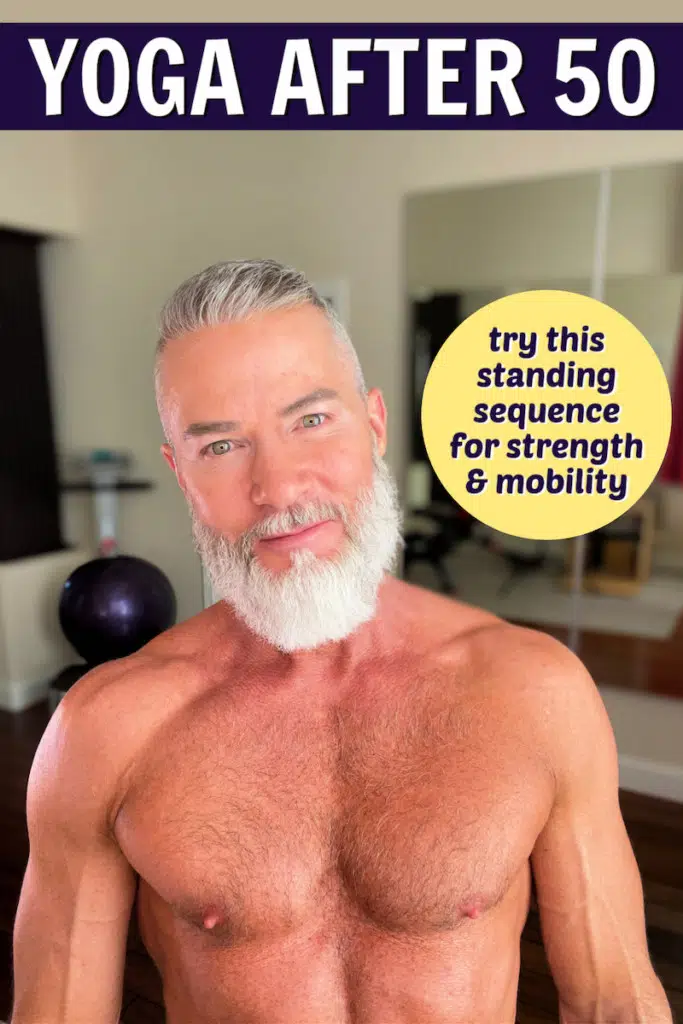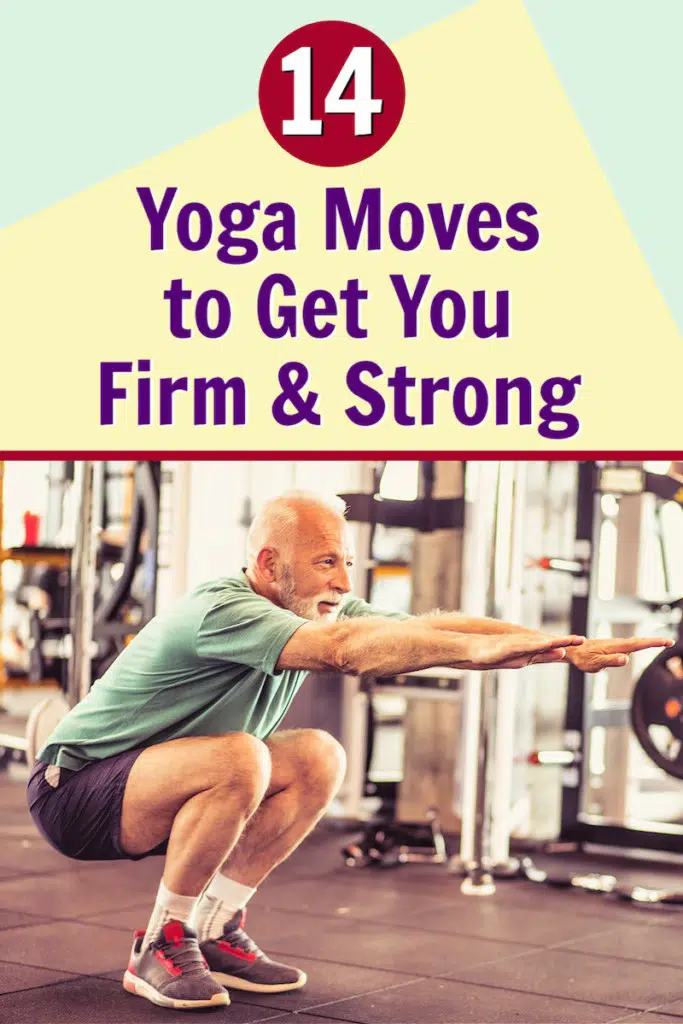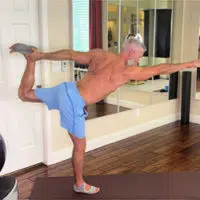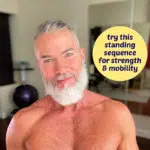Practicing yoga over 50 can help to slow the aging process and – if done consistently in combination with a healthy diet – can keep you strong, trim, and fit. A flowing routine of standing poses will improve your joint mobility (including your spine), muscular flexibility, lung capacity, and core strength.
What follows is a recommended practice for yoga over 50. A video and printable list of exercises are included lower within this article.
Yoga for Mobility (and to Reduce Risk of Accelerated Aging)
The ability to move easily and freely – at different depths and in various situations – is called mobility.
There is a misunderstanding that to keep your joints healthy and supple, you must avoid using them.
In fact, it’s the opposite.
To maintain healthy joints, you must use them for their intended purpose: to move!
Utilizing your joints unstiffens the surrounding synovial fluid, which allows the liquid to lubricate the movement process better.
Of course, the key is to use your joints safely. This means your yoga poses should be executed so they feel challenging but not painful.

Scientific research studies have established (see sources at article’s end) that yoga has a positive impact on wellness – including brain function, heart health, mood, overall quality of life, and mobility.
Your true internal age isn’t always revealed by looking at yourself while standing in front of a mirror.
Your true age is more often revealed by how you move and what you look like while walking.
This is what it means to have good mobility. Your joints move correctly, and your muscles are flexible – and that reveals itself visually by your posture and youthful countenance as you walk and bend.
How is your joint mobility:
- stiff?
- or, supple?
How is your posture:
- neck craning forward and a kyphotic hump?
- or, do you have a tall, flexible spine with centered shoulders?
How are you aging:
- slowly?
- or unnecessarily fast?
Done properly, yoga over 50 will improve all of these aspects of your physicality.
“How Often Should I do Yoga?”
It’s beneficial to do yoga at least once each week.
In midlife and post-midlife, the weekly mobility workout – be it swimming, Pilates, yoga, or stretching and mobility drills – becomes the foundation of your entire fitness regimen.
Your once-a-week flexibility session is what makes all the other workouts throughout the week possible.
Yoga over 50 is the simplest solution because it’s more convenient (and less expensive) than Pilates or lap swimming.
How Long to Hold a Yoga Pose
For thousands of years, yoga enthusiasts have alternated quickly between forward bends and backward bends to great benefit.
Moving through the alternating poses in this way helps to condition the major muscle groups so that they develop symmetrically.
Here is a good general guideline for how long to hold a yoga pose:
- Beginners can hold each pose for approximately 30 seconds.
- Intermediate-level practitioners can hold a pose for 45 seconds.
- Advanced yogis can hold a full minute.
Challenges of Yoga Over 50
Our lifestyle today is different than it was thousands of years ago:
- Today, we drive, sit at desks, and use phones.
- We are far more sedentary and experience different mental stressors.
- We’re also fatter now and, perhaps most importantly, we eat inflammatory foods and live in an environment awash in synthetic chemicals.
Because of all of this, it’s imperative that we not move too aggressively between forward bends and backbends.

As you begin your yoga practice, I encourage you to proceed cautiously (you need to develop your flexibility more gradually than our ancestors needed to in the past):
- Moving instantly from flexion (forward) into extension (backward arch) can put strain on the sacro joint.
- The sacroiliac joint connects the hip bones to the triangular bone between the lumbar spine and the tailbone and absorbs shock between the upper body and the pelvis and legs.
- Unless you’re already lean, strong, and highly flexible, you want to proceed gently with this area.
- Make your forward bends and backward bends less extreme in the beginning.
- In particular, any pose in which you arch or sway your lower back needs to be entered respectfully.
- Avoid the temptation to go too far.
- Be mindful of the soles of your feet.
- It’s tempting to roll the weight of your body to one side or the other. But in many standing poses, your safest bet is to make contact with the ground using the entire sole of your foot.
- Keep your feet active in standing poses by consciously pressing your feet down into the ground.
- In standing poses, it’s tempting to lock out (hyperextend) your knee joints. But in many standing poses, you want to keep your knees slightly bent while supporting body weight.
Here is a sequence of 14 poses that I have found to be very beneficial:
- Mountain Pose into parasympathetic breathing sequence
- Crescent
- Powerful (Utkatasana)
- Awkward (high into low)
- Eagle
- Prayer Twist
- Backward Bend (low into high)
- Forward Bend
- Runner’s Lunge into Warrior One (flow)
- Warrior Two into Triangle variation
- Toppling Tree
- Dancer
- Tree
- and Shavasana.
Yoga Over 50 in Your Area
I believe the most important yoga work is done alone on your mat during quiet – whether outside or in your home gym area.
In my opinion, your yoga practice should include this: just you moving in silence on a mat alone.
By doing yoga in this way, you will discover aspects about yourself – physically and psychologically – that you might not otherwise find.
Additionally, yoga within a community class environment also offers unique benefits.
If you’re fortunate to live in an area that has a Modo Yoga studio, you might want to give a class there a try:
- They offer Flow and HIIT classes, but my favorite is the classical Modo class done in a heated room.
- Anecdotally, I can tell you that I did classes once a week in this way for two years in a row, and I never felt or looked better in my entire life. Highly recommended!
Yoga in Combination with Anti-Inflammatory Nutrition
Doing a mobility session once each week can be a game-changer in and of itself.
However, doing yoga over 50 in conjunction with an anti-inflammatory diet can reap exponentially positive results – helping you to develop lean muscle and reduce belly fat.

Mobility Poses for Yoga Over 50
Over the age of fifty? Try this sequence of standing yoga over 50 poses that will improve your core strength, balance, and flexibility.
Tools
- Optional: a mat, block, and hand towel.
Instructions
- Mountain Pose into parasympathetic breathing sequence.
- Crescent.
- Powerful (Utkatasana).
- Awkward (high into low).
- Eagle.
- Prayer Twist.
- Backward Bend (low into high).
- Forward Bend.
- Runner's Lunge into Warrior One (flow).
- Warrior Two into Triangle variation.
- Toppling Tree.
- Dancer.
- Tree.
- Shavasana.
Notes
- Resist the temptation to hold your breath.
- Move slowly and proceed cautiously.
- It can be helpful if the room isn't too cold.
Speaking personally, nothing has improved my mobility and joint health more than switching to an anti-inflammatory diet.
My new course is designed in a specific sequence to help you achieve the next level of robust health – by taking you step-by-step through the process of adopting an anti-inflammatory diet.
Benefits of Yoga Over 50
The proven benefits of yoga over 50 are significant. Yoga over 50 can:
- decrease excess stress hormones such as cortisol and adrenaline
- soothes the sympathetic nervous system
- improve diet mindfulness (a calmer mind makes better food choices)
- reduce inflammation
- reduce overall fatigue and improve mood and mental clarity
- improve brain chemistry
- reduce physical discomfort (including headaches and chronic pain) and improve sleep
- improve balance, flexibility, and breathing
- increase strength in the major muscle groups, especially the core.
After becoming familiar with the above sequence of standing yoga poses for developing strength, you can then move on to the all-important yoga floor stretches – to further deepen and improve your flexibility.
Additional Sources for Doing Yoga Over 50:
Positive Effects of 12-Week Hatha Yoga Intervention – https://www.ncbi.nlm.nih.gov/pmc/articles/PMC4475706/
Randomized Control Study in Impact of Yoga on Eating Habits – https://www.ncbi.nlm.nih.gov/pmc/articles/PMC2844876/
Clinical Trial on Influence of Pranayama Breathing Techniques on Lung Capacity – https://www.ncbi.nlm.nih.gov/pmc/articles/PMC3017963/
10 Weeks of Yoga Beats the Flexibility of Control Group – https://www.ncbi.nlm.nih.gov/pmc/articles/PMC4728955/
Research Establishes that Seniors Who Do Yoga Sleep Better – https://pubmed.ncbi.nlm.nih.gov/15937373/
Mental Stillness During Yoga’s Final Shavasana Pose Reduces Overall Anxiety – https://examine.com/supplements/meditation/
Effect of Yoga Practice on Levels of Inflammatory Markers – https://www.ncbi.nlm.nih.gov/pmc/articles/PMC4525504/
Yoga’s Impact on Wellness – https://www.ncbi.nlm.nih.gov/pmc/articles/PMC3193654/
